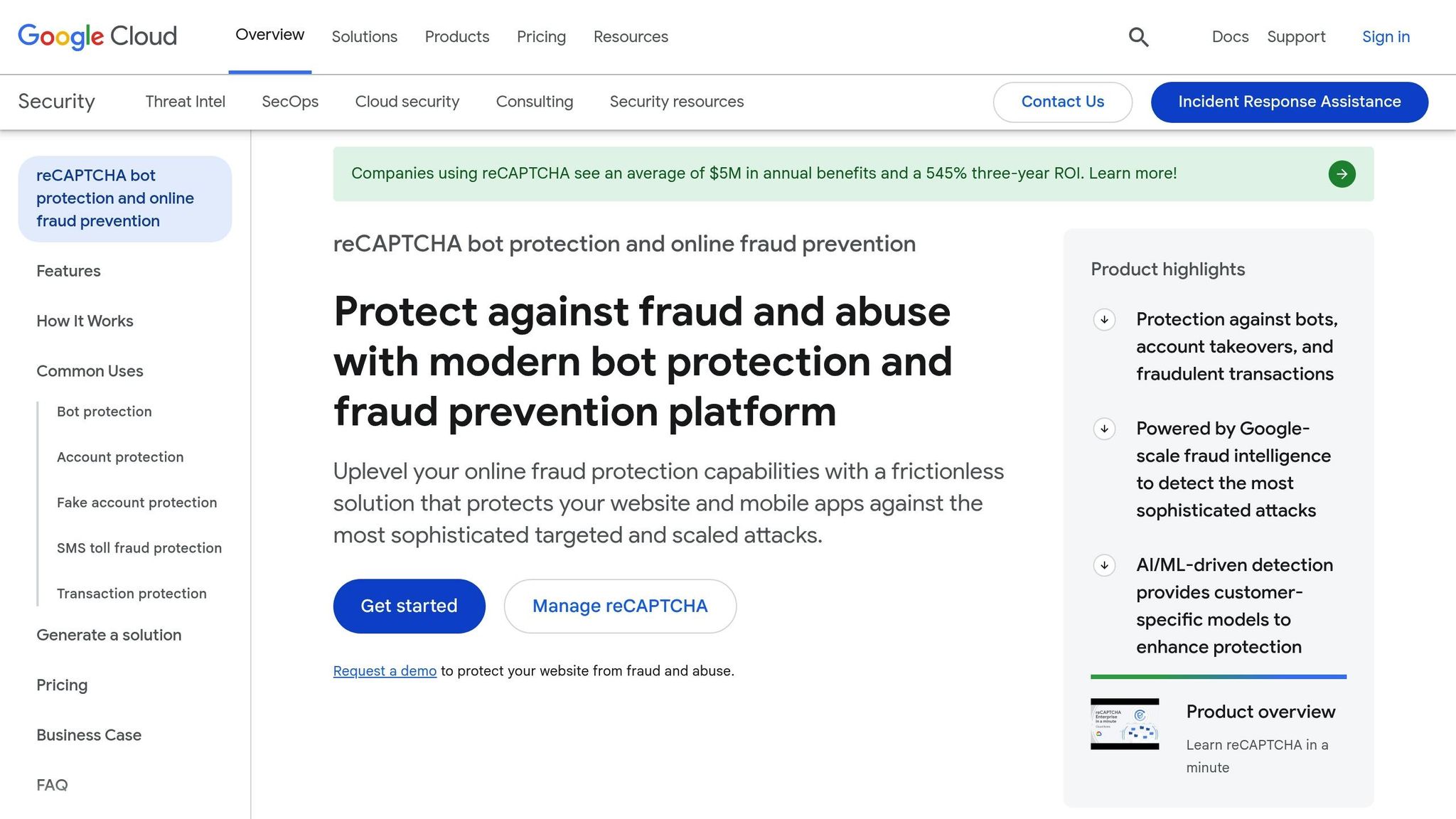How to Stop Bots Submitting Forms

Bots submitting forms can waste your time, skew your data, and even pose security risks. If you're not protecting your forms, bots could account for over half of your submissions, leading to fake leads, corrupted analytics, and compliance headaches. Here's how you can stop them:
- CAPTCHAs: Use visible or invisible CAPTCHAs to differentiate between humans and bots.
- Honeypot Fields: Add hidden fields that bots fill out but humans don't see.
- JavaScript Validation: Monitor typing speed, mouse movements, and form completion time.
- Server-Side Validation: Verify input on the server to catch bots bypassing client-side checks.
- Rate Limiting: Restrict the number of form submissions per IP address.
- Web Application Firewalls (WAF): Block malicious traffic by analyzing HTTP/HTTPS requests.
For non-technical teams, no-code form builders like Reform offer built-in anti-spam tools, including real-time email validation, honeypots, and spam filters. These solutions make it easy to secure your forms without needing advanced technical skills.
To stay ahead of evolving threats, combine multiple layers of protection. This ensures your forms remain secure while maintaining a smooth experience for real users.
Form Spam Prevention: Essential Strategies
Bot Prevention Basics
To protect your forms effectively, it’s essential to grasp how bots operate and why they target forms in the first place.
What Are Bots and Why Do They Target Forms?
Bots are automated programs designed to perform repetitive tasks. While some bots, like search engine crawlers, are beneficial, the ones targeting your forms often have malicious goals. These harmful bots come in different forms, each with specific objectives:
- Spam bots: These flood forms with irrelevant or junk data, often to promote products or websites.
- Phishing bots: Their goal is to collect sensitive personal information by submitting fake entries.
- Credential stuffing bots: These attempt to gain unauthorized access by using stolen usernames and passwords across multiple forms.
A more advanced breed, known as fourth-generation bots, can mimic human behavior so convincingly that even traditional fraud detection systems can fail. For example, in 2024, nearly 25,000 fraudulent applications bypassed a major bank’s safeguards, highlighting the growing sophistication of these programs.
Forms are a prime target because they offer direct access to valuable data like contact information, login credentials, and registration details. Additionally, forms often trigger automated processes that attackers can exploit to compromise systems further.
Understanding these tactics emphasizes why businesses must prioritize strong bot prevention measures.
Why Bot Prevention Matters for Businesses
The consequences of unchecked bot activity can be severe. Malicious bots distort data quality, making it harder to distinguish between genuine users and automated threats. This not only affects analytics but also undermines trust in your systems.
Complicating matters, attackers are constantly refining their methods, which makes distinguishing between legitimate and harmful bots increasingly challenging. As a result, businesses must adopt resilient, multi-layered defenses to stay ahead.
Building an effective protection system requires a deep understanding of bot behavior. Key factors to analyze include request frequency, user agent strings, traffic origins, and response patterns. By identifying these characteristics, businesses can better differentiate between real users and automated threats, ensuring their systems remain secure.
Proven Methods to Stop Bot Form Submissions
Blocking bots effectively requires a mix of techniques like CAPTCHAs, honeypot fields, and JavaScript validation. When combined, these methods create layers of defense to address a variety of automated threats.
Setting Up CAPTCHA and reCAPTCHA

CAPTCHA, short for "Completely Automated Public Turing test to tell Computers and Humans Apart", is one of the most trusted ways to distinguish between humans and bots. These systems present challenges that are simple for humans but difficult for automated programs.
Traditional reCAPTCHA includes options like checkbox challenges ("I'm not a robot") or image-based tasks where users identify objects like traffic lights or crosswalks. Invisible reCAPTCHA, on the other hand, works in the background by analyzing user behavior, only stepping in with challenges if something seems off.
To make CAPTCHAs less intrusive, consider alternatives that improve accessibility. For instance, offer audio options for visually impaired users and ensure the CAPTCHA is keyboard-friendly. Placing CAPTCHAs strategically - like just before the final "Submit" button - can reduce user frustration while still maintaining security.
But CAPTCHAs aren't the only solution. Other methods can work silently in the background to catch bots.
Using Honeypot Fields to Catch Bots
Honeypot fields are a clever way to trap bots using hidden form inputs. These fields are invisible to human users but visible to bots, which often fill out every field they detect.
To set up a honeypot, add a hidden input field to your form and use CSS (e.g., display: none) to hide it from view. Human users will leave this field blank, but bots are likely to populate it. If the honeypot field contains data when the form is submitted, you can flag the entry as suspicious and reject it.
This method is seamless for users since they won’t even know the honeypot exists. However, advanced bots may be able to detect and avoid hidden fields by analyzing your CSS or JavaScript. To counter this, use unpredictable field names instead of obvious ones like "spam-trap" or "honeypot."
For an extra layer of protection, consider adding behavioral checks.
JavaScript Validation and Behavioral Analysis
JavaScript-based techniques analyze user behavior to distinguish between humans and bots. These methods track patterns like typing speed, mouse movements, and the time spent filling out forms.
Real-time validation checks inputs as users fill out the form. For example, if a form is submitted almost instantly after loading, it’s likely a bot, as humans need time to read and enter information. Similarly, bots often move cursors in overly precise paths, unlike the natural, less predictable movements of human users. Real-time checks can also validate data formats, such as ensuring email addresses or phone numbers are correctly structured, stopping bot entries before they reach your server.
However, bots may bypass JavaScript entirely, so pairing it with server-side validation strengthens your defenses.
| Method | User Experience | Bot Detection | Accessibility |
|---|---|---|---|
| reCAPTCHA | Moderate | High | Variable |
| Honeypot Fields | Invisible | Low-Moderate | Good |
| JavaScript Validation | Seamless | Moderate | Good |
sbb-itb-5f36581
Server-Side and Network-Level Protection
While client-side defenses act as the first line of protection, server-side and network-level measures provide a more robust shield that bots find much harder to bypass. These back-end strategies work independently of the user's browser, creating a solid barrier against automated attacks. Let's dive into how server-side validation, rate limiting, and Web Application Firewalls (WAFs) fortify your defenses.
Server-Side Validation and Rate Limiting
Server-side validation serves as one of the most dependable defenses because bots often bypass client-side checks by interacting directly with your server. By implementing validation on the server, you can catch suspicious submissions before they reach your database. For example, if a form requires a valid email address, verify its format on the server and consider using real-time email validation tools to ensure accuracy. Similarly, validate other critical fields like phone numbers and required inputs server-side, rather than relying solely on client-side checks.
Time-based checks are another effective server-level tactic. By tracking how quickly forms are filled and submitted, you can flag entries completed at unrealistically fast speeds - something bots are notorious for.
Rate limiting adds an additional layer of protection by capping the number of submissions allowed from a single IP address within a set timeframe. This not only prevents server overload but also stops bots from spamming your forms. For instance, you could restrict contact form submissions to 3–5 per IP per hour or limit login attempts to around 10 tries. Services like Cloudflare’s rate limiting can even enforce limits on mobile app requests, such as 100 requests every 10 minutes.
To further enhance security, filter incoming requests against databases of known proxy and VPN IP addresses. While many bots use these services to mask their locations, keep in mind that legitimate users may also use VPNs for privacy reasons, so apply these filters thoughtfully.
Using Web Application Firewalls (WAF)
Web Application Firewalls (WAFs) are designed to analyze HTTP/HTTPS traffic, blocking application-layer attacks by inspecting headers, IP addresses, and traffic patterns. Given that nearly 20% of all Internet traffic originates from malicious bots, a WAF is a critical component of your security strategy.
For businesses without dedicated IT teams, cloud-based WAFs are often the easiest to implement. These solutions are typically simpler to set up than network- or host-based firewalls and can include additional features like content delivery networks (CDNs) to improve both site performance and security.
When deploying a WAF, it’s crucial to fine-tune its rulesets to align with your specific forms and applications. Generic rules may inadvertently block legitimate users or fail to detect sophisticated bot behavior. Regularly updating your WAF’s configurations is essential to keep up with evolving bot tactics.
While WAFs are excellent at preventing large-scale attacks, they may struggle against advanced bots that mimic human behavior or use residential IP addresses. Pairing WAF protection with rigorous server-side validation creates a more comprehensive and effective defense. Integrating these server-side measures with client-side protections ensures a multi-layered approach to combating automated threats.
| Protection Method | Implementation Level | Bot Detection Rate | Setup Complexity |
|---|---|---|---|
| Server-Side Validation | Backend | High | Moderate |
| Rate Limiting | Backend | Moderate | Low |
| Web Application Firewall | Network | High | Low–Moderate |
The strength of your bot prevention strategy lies in layering these server-side and network-level defenses with client-side measures. While no single method can guarantee complete protection, combining multiple techniques makes it much harder for bots to succeed, all while ensuring a smooth experience for legitimate users.
How No-Code Form Builders Make Bot Prevention Easy
No-code form builders are a game-changer for teams without technical expertise, especially when it comes to keeping bots out. These platforms come preloaded with anti-spam tools, making it simple for businesses of any size to secure their forms without needing a dedicated IT team.
Here’s why this matters: almost 28% of web form submissions are spam, and contact forms are a frequent target for spambots. For companies without the resources to manually set up CAPTCHAs, honeypots, or server-side validation, no-code form builders simplify the process by offering these features as built-in options. Activating them is as easy as flipping a switch or selecting from a dropdown menu.
What sets these platforms apart is how they combine multiple anti-spam methods in one place. Instead of having to choose between different tools, businesses can layer them together - something that would typically require significant development work if done from scratch. Let’s dive into how Reform’s tools make bot prevention straightforward.
Spam Prevention Features in Reform

Reform tackles bot prevention with a range of built-in tools that ensure your forms are only filled out by real people.
Real-time email validation is one standout feature. As users type, Reform instantly checks email addresses for validity, reducing bounce rates and catching fake entries before they even hit your system. This isn’t just about formatting - Reform also verifies that email domains exist and can receive messages, blocking the disposable addresses often used by bots.
Reform also makes CAPTCHA implementation effortless. With just one click, you can activate this feature, which is proven to cut spam submissions by up to 95%. The system handles all the technical setup behind the scenes, so you don’t have to.
Another powerful tool is the honeypot field, which Reform sets up automatically. This invisible trap catches bots, blocking up to 90% of automated spam without causing any inconvenience for legitimate users.
Behind the scenes, advanced spam filters analyze every submission, looking at factors like IP reputation, submission speed, and content patterns to flag suspicious activity. These filters work continuously, ensuring your forms remain secure.
Reform also provides real-time analytics, giving you instant insights into form performance and potential security threats. You can track unusual submission spikes, monitor trends, and adjust your settings to stay one step ahead of bots. This data-driven approach allows businesses to fine-tune their defenses as needed.
Improving Lead Quality with Reform's Tools
Reform doesn’t just block spam - it also helps businesses collect higher-quality leads through smarter form design. One key feature is multi-step forms, which naturally filter out bots and encourage thoughtful responses from genuine users.
Multi-step forms require users to navigate through several screens and input different types of information. Bots, which often struggle with complex workflows, are less likely to complete these forms. Conditional logic adds another layer of complexity, showing follow-up questions based on previous answers. This ensures that the submissions you receive are more likely to come from engaged, legitimate prospects.
Reform’s conditional routing takes this a step further. By creating dynamic forms that adapt to user responses, businesses can offer a personalized experience while making it nearly impossible for basic bots to navigate. For example, a lead generation form might display different questions based on the user’s industry or company size.
The platform also includes lead enrichment tools that automatically gather additional details about form submitters, such as company information, social profiles, and contact verification. This helps businesses identify high-value prospects while spotting potential red flags, like mismatched data or fake profiles.
Email validation and verification work seamlessly throughout the form process. Instead of waiting until submission to check email addresses, Reform validates them in real time. Users are prompted to fix typos or invalid formats immediately, ensuring every submission includes a working email address. This proactive approach significantly boosts follow-up success rates.
To further enhance quality, Reform supports double opt-in workflows, which can cut spam signups by 50%. Setting up these confirmation processes is simple with Reform’s visual builder, allowing users to automate confirmation emails and follow-ups without writing a single line of code.
Conclusion: Building Secure, High-Performing Forms
Protecting your forms requires a layered strategy that not only defends against cyber threats but also ensures you’re capturing high-quality leads. With AI-driven cybercrime projected to grow by 37% annually between 2023 and 2030, relying on a single defense mechanism simply isn’t enough.
Using a combination of rate limiting, CAPTCHAs, and honeypot fields helps manage traffic and block bots effectively. Adding server-side validation offers an extra layer of security, ensuring that malicious traffic is stopped without disrupting real users. These tools work seamlessly with modern form builders, making it easier to implement robust protection.
Platforms like Reform simplify the process of securing your forms. Instead of manually configuring complex features like CAPTCHAs or honeypots, Reform enables you to set up enterprise-grade security with just a few clicks. Features like real-time email validation, automatic spam filtering, and multi-step forms ensure that you're collecting genuine leads from engaged users. By combining no-code solutions with these advanced techniques, you can strengthen your defenses without adding complexity.
The challenge lies in balancing security and usability. Forms should be secure enough to block even the most advanced bots but still user-friendly to encourage completion. By implementing HTTPS encryption, adhering to privacy regulations like GDPR, and validating inputs on both the client and server sides, you can create forms that not only protect your business but also convert visitors into leads.
Staying ahead of evolving threats is crucial. By combining robust, multi-layered defenses with tools like Reform, you can build secure forms that perform exceptionally well - capturing genuine leads and keeping your business safe.
FAQs
How can businesses secure their forms from bots without harming the user experience?
To keep forms secure from bots without making things difficult for users, businesses can rely on subtle security measures like reCAPTCHA, JavaScript validation, and server-side checks. These tools work well to filter out spam submissions while ensuring legitimate users aren't inconvenienced.
It's also important to design forms that are simple and accessible. For instance, make sure CAPTCHA challenges are straightforward and avoid adding unnecessarily complicated fields that might turn users away. By embedding security features naturally into the form's design, you can protect against bots while ensuring the experience remains smooth and hassle-free for real users.
How can businesses identify if a form submission is from a bot?
Bots often reveal themselves through distinct patterns in form submissions. These can include lightning-fast completion times (like under 2 seconds), repeated entries from the same IP address, gibberish or repetitive answers, and a lack of typical user behavior, such as scrolling or mouse movement.
To spot these red flags, businesses can keep an eye out for unusual traffic surges, examine submission trends, and look for duplicate or questionable responses. Implementing tools like CAPTCHA or reCAPTCHA, combined with behavior-based validation methods, can go a long way in blocking bot activity effectively.
How can no-code form builders like Reform help non-technical teams prevent bot submissions?
No-code form builders, such as Reform, simplify the process of setting up bot prevention measures for teams without technical expertise. These platforms typically offer built-in features like CAPTCHA, JavaScript validation, and server-side checks, which can be enabled in just a few clicks.
Thanks to their intuitive interfaces and pre-configured security options, Reform empowers teams to protect their forms from spam and bot activity with ease. This not only minimizes the reliance on developers but also ensures your submissions remain accurate and your data stays secure.
Related posts
Get new content delivered straight to your inbox

The Response
Updates on the Reform platform, insights on optimizing conversion rates, and tips to craft forms that convert.
Drive real results with form optimizations
Tested across hundreds of experiments, our strategies deliver a 215% lift in qualified leads for B2B and SaaS companies.


.webp)



